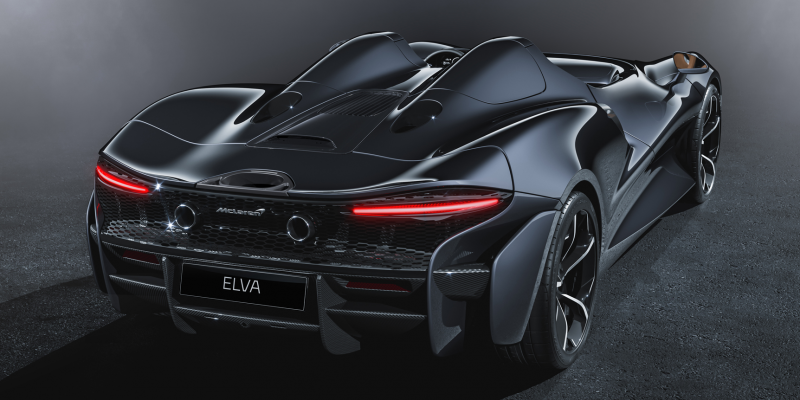- McLaren has debuted its latest supercar: the Elva roadster.
- The $1.68 million Elva roadster is a first of its type for McLaren. It doesn’t have a roof, windshield, or windows; instead, an “Active Air Management System” cocoons passengers by changing the airflow around them.
- The Elva is an homage to the M1A of the 1960s, a car designed by founder and champion racer Bruce McLaren.
- Only 399 examples will be made.
- Visit Business Insider’s homepage for more stories.
McLaren just debuted its latest supercar: the $1.68 million “Elva.”
“It’s fitting that the new McLaren Ultimate Series roadster – a uniquely modern car that delivers the ultimate connection between driver, car, and the elements and with that new heights of driving pleasure on-road or track – acknowledges our rich heritage with the Elva name,” McLaren CEO Mike Flewitt said.
The Ultimate Series is what it sounds like: McLaren’s most outrageous machine. The Elva joins the Senna, Senna GTR, and Speedtail.
McLaren has never before produced an open-cockpit design, and the British brand’s debut effort is unique: it lacks a roof, windshield, or windows (a fixed windshield add-on is available, however). The automaker said its first open-cockpit vehicle makes for an “incredibly immersive and enthralling experience.”
Only 399 examples of the car will be made, each going for $1.68 million.
Elva also has a bespoke carbon fiber chassis, body, and seats. The Elva is "the lightest road car we've ever built at McLaren Automotive," vehicle line director Andy Palmer said in a statement.
The window-less vehicle pays homage to the 1960s-era M1A racer, designed by founder Bruce McLaren. That car had a potent V8 and distinctive, lightweight-resin bodywork. Customers wanted to get their hands of a road version so badly that McLaren, a small operation, partnered with England's Elva Cars Ltd. to build three iterations of the machine: the McLaren-Elva M1A, M1B, and M1C.
The automaker also claims the "shapes (of the car) are organic and natural ," with the only disruption being the instrument cluster.
There is no clear distinction between the interior and exterior of the car, McLaren noted. This creates a "blurred boundaries" design. The doors and buttress behind the seats flow into the cabin. The front of the car is made of a one-piece panel that wraps around the entire nose, creating a clean appearance. Similarly, the body panels wrap from the front wheels to the active rear spoiler.
In terms of safety, helmets aren't required because the upper cabin surrounds around its passengers. There's also an Active Air Management System (AAMS) that cocoons occupants by changing the airflow and directing it over the heads of driver and passenger, creating a "bubble of calm," according to the automaker. This is done by in-taking air through the nose of the car and funneling it up through a vent.
The AAMS will automatically activate as the speed of the car increases.
Keep scrolling to check out this new piece of high-tech insanity from the Wizards of Woking:
The Elva is a two-seat roadster, pictured here with the windshield attachment. It's the latest in McLaren's ultra-high-end Ultimate lineup.

McLaren's 4.0-liter, twin-turbocharged V8 engine makes 804-horsepower with 590 pound-feet of torque and propels the mid-engine Elva to a 0-60mph time of less than there seconds, according to the automaker. This is the same motor as the McLaren 720S, Senna, and Senna GTR.

In addition to a familiar carbon-fiber monocoque chassis, the Elva makes abundant use of additional carbon fiber, from the signature "dihedral" doors to carbon-ceramic brakes.

The Elva's contoured body shape guides air to optimize the car's aerodynamic efficiency, according to the automaker.

The exhaust system is made of lightweight titanium and Inconel. There's a pair of rear exhaust ports along with a top-mounted dual port.

There eight-inch infotainment touchscreen is as modest as these units typically are for McLaren, but the interface is new and includes navigation, a rear-view camera, and climate controls. The screen is mounted on a carbon-fiber arm that tilts toward the driver.

Buyers can customize the Elva's interior, and among their options is four-layer "Ultrafabric." McLaren said the outer surfaces provide durability and moisture resistance while the inner layers add a "reinforced rayon-fiber base" and cushioning material. This stuff can evidently "grip" driver and passenger for a snug ride.

"The McLaren Elva ... exists purely for the pleasure of driving, to deliver an enthralling and immersive experience born from the ultimate connection between the car, the driver and the elements," McLaren's Andy Palmer said.

Only 399 examples of the Elva will be made.

The car starts at $1.69 million. The final price depends on how much extra work buyers ask McLaren Special Operations to bring to the party.


